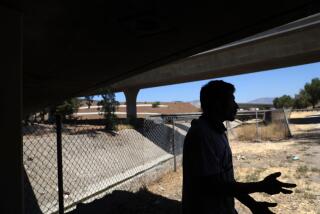Building a Niche in Bus Shelters : Advertising: A 6-by-4-foot panel can rent for $500 to $600 per month, more in a choice location. The ads reach consumers in areas where outdoor advertising is banned.
IRVINE — As president of Southern California’s largest bus shelter company, Jean Claude LeRoyer knows about manufacturing and advertising. He also has learned a little about censorship.
After some recent complaints, LeRoyer decided to pull the plug on a series of bus shelter ads for a rock music radio station in several Orange County cities. The ads depicted a “flasher” in a raincoat confronting an elderly woman.
“We’re in an awkward position,” said LeRoyer, who heads Bustop Shelters of California. “We have $20 million worth of bus shelters on the street and we don’t want to jeopardize it for one advertisement.”
The canceled ad cost his company $40,000, but LeRoyer said that’s a small price to pay to make sure his firm maintains a good image.
Irvine-based Bustop and its two principal competitors--Target Media in Anaheim and Gannett Transit in Los Angeles--vie for contracts from Southern California transit districts to install bus shelters along major routes.
“It’s a win-win situation,” said Bruce K. Seidel, managing general partner for Target Media. “It’s proven that bus shelters promote rapid transit. The shelters are very visible.”
The bus shelter suppliers benefit by receiving revenue from the companies that place ads in the shelters. The cities not only get shelters built at no charge to taxpayers, but also receive a one-time payment, sometimes called a “signing fee,” plus monthly fee ranging between $75 to $150 a shelter. And bus riders get a shady, dry spot in the urban wilderness.
Like the rest of the ad industry, the shelter companies have been hit by the recession. Company executives say business is down 5% to 10% in the past year. Nevertheless, the companies say they are making progress in convincing companies of the effectiveness of bus shelter marketing.
If nothing else, shelters can reach consumers in areas where other outdoor advertising is not permitted. In cities in Orange County and elsewhere in the Southland, stringent zoning laws have significantly reduced the number of billboards.
“If an advertiser wants to cover Los Angeles and Orange counties, it can’t be done with traditional billboards,” Seidel said. “You can do it with bus shelters.”
And cover it they do. Founded in 1984, Bustop now has 2,000 shelters in Southern California and southern Nevada, about a sixth of those in Orange County. Target Media, which has been operating since 1975, has 350 shelters, mostly in Orange County.
Gannett Transit, a unit of Gannett Corp.’s outdoor billboard subsidiary, entered the Southern California market for bus shelters three years ago when it bought Shelter Media. It now has 1,500 shelters in Los Angeles, San Diego and Riverside counties.
Bus shelters have been popular for years in Europe. But while bus benches have been around for a long time, the bus shelter concept did not catch on big in America until the 1970s and 1980s. LeRoyer, a Frenchman who saw the growing popularity of shelters in Paris, worked for shelter companies in New York and Chicago before coming to Newport Beach and founding Bustop.
It was tough going at first.
“The advertising agencies are very conservative and they go with their media--television, radio, newspapers,” he said. Gradually, bus shelter advertising began to gain respectability.
Both LeRoyer and Target Media’s Seidel credit the entrance of Gannett, part of the nation’s largest media company, with helping to boost the industry’s image. Says Seidel: “When Gannett got into the business, it gave it a stamp of approval.”
Executives of the three companies say competition is fierce. Gannett Transit boasts, for example, that it is backed by a huge corporation. LeRoyer retorts that Bustop is smaller and can be more responsive to the needs of customers and advertisers.
All of the companies are trying to expand into new territory. Seidel said Target Media hopes to add another 50 to 100 shelters this year. Bustop has expanded into Las Vegas and has its sights set on the San Francisco Bay area.
The cities have their own demands. Increasingly, the bus shelter companies are being asked to produce custom-designed shelters for certain cities. Buena Park officials asked for copper-roofed shelters, for example, and the city of Riverside wanted its shelters painted the color mauve. With a basic shelter already costing $3,000, LeRoyer said he worries that other cities may make similar demands for modifications, driving up manufacturing costs.
Advertisers pay handsomely for the right to place their posters in shelters. The companies charge between $500 and $600 per month for each 6-by-4-foot panel. Some high-visibility locations, such as airports, can command $1,100 a panel.
The ads are not designed to reach bus riders or pedestrians but are aimed primarily at catching the attention of passing motorists. “We’re vehicular. The shelters are at eye level,” said Doreen Roberts, vice president for Gannett Transit.
As such, advertisers who may have lots of experience with TV, print media or billboards are having to learn a few new tricks about bus shelters.
“One thing we have learned is to make the colors big and bright,” said Bonnie Crail, executive vice president for marketing at Ocean Pacific Sunwear in Tustin. The company logo must be placed in the upper half of the poster, she said, or it can’t be seen when someone parks a vehicle near the shelter.
Crail said OP has been using bus shelter ads for about five years to reach young people at beaches where there are no billboards. “We generally like arteries that go toward the beach or where there is a lot of young traffic,” she said.
Ego Sportswear, a small surf-wear company in Yorba Linda, said the posters work well at reaching customers in particular cities where the company’s apparel is sold. “Basically, we want to throw our name out there,” said Ivory Sully, an Ego vice president.
More to Read
Sign up for Essential California
The most important California stories and recommendations in your inbox every morning.
You may occasionally receive promotional content from the Los Angeles Times.









